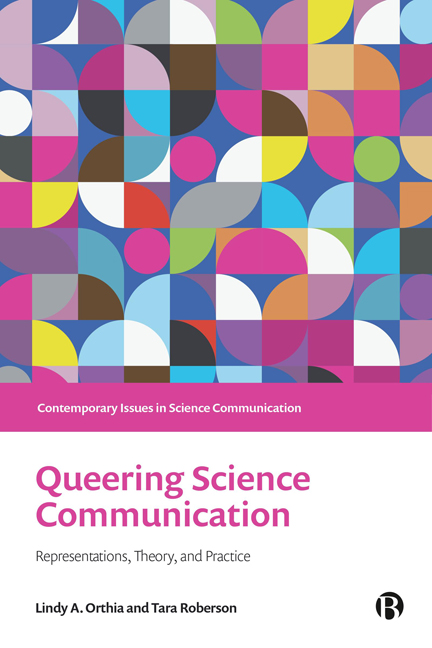Book contents
- Frontmatter
- Contents
- Series Editor Preface
- Notes on Contributors
- Acknowledgements
- Terminology and Sensitive Content in This Book
- Introduction
- PART I Negotiating Queer Identities with Science, Technology, and Medicine
- PART II Representations of Queerness in Public Science Communication
- PART III Queer People in Science Communication Communities
- PART IV Queering Institutional Science Communication Agendas
- Conclusions
- Index
Series Editor Preface
Published online by Cambridge University Press: 18 January 2024
- Frontmatter
- Contents
- Series Editor Preface
- Notes on Contributors
- Acknowledgements
- Terminology and Sensitive Content in This Book
- Introduction
- PART I Negotiating Queer Identities with Science, Technology, and Medicine
- PART II Representations of Queerness in Public Science Communication
- PART III Queer People in Science Communication Communities
- PART IV Queering Institutional Science Communication Agendas
- Conclusions
- Index
Summary
As science communication continues to establish itself as a discipline in the 21st century, there has never been a better time to consider contemporary science communication and its practices. Misinformation and digital marketing are changing the context for science journalism. Emerging political eras are altering the way we think about expertise and trust in policymaking, as well as the power of protest. Predatory publishing, open access and the use of social media are presenting novel contexts for researchers to consider in the communication of their work. Meanwhile, there are contemporary scientific and technological developments that are consistently generating important ethical and social questions. Against this backdrop in 2020, we faced one of the greatest global health issues in a generation, with the onset of the COVID-19 pandemic. Whilst international events, and social movements have drawn heightened attention to questions of inclusion, equity and the abuse of power.
Contemporary Issues in Science Communication is a multidisciplinary series, welcoming submissions from a wide range of disciplinary areas, and international in outlook. Books contained in the series seek to be engaging, straightforward and conversational style, and of interest to science communication practitioners as well as academic audiences.
Books published in the Contemporary Issues in Science Communication series consider such science matters and their relationships to communication, engagement and broader social conversations. The series links the present with the past by publishing titles that develop our understanding of the history of science communication, both in practice and as an academic discipline. However, they also cover a range of topics relevant to contemporary science communication, including, but not limited to: definitions, history and ethics of science communication; expertise, replication and trust; interdisciplinary knowledge; ideologies; knowledge and new forms of media; public policy; gaming, sci-art and visual communication and inclusivity in science communication. The scope of the series is broad but so are the challenges facing science communicators and public engagement practitioners.
In this book, the first in the series, Tara Roberson and Lindy A. Orthia encapsulate these ambitions. In Queering Science Communication: Representations, Theory and Practice, they bring together an edited collection of insights that highlight the intersections of queerness and science communication.
- Type
- Chapter
- Information
- Queering Science CommunicationRepresentations, Theory, and Practice, pp. viii - ixPublisher: Bristol University PressPrint publication year: 2023

